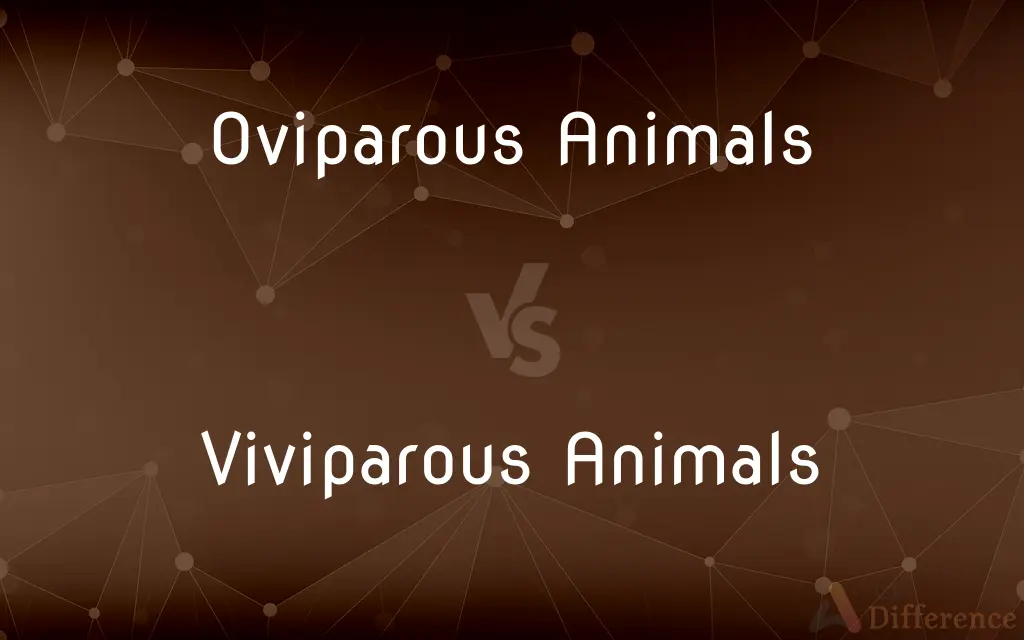Oviparous Animals vs. Viviparous Animals — What's the Difference?
Edited by Tayyaba Rehman — By Fiza Rafique — Published on November 2, 2023
Oviparous animals lay eggs that develop outside the mother's body; viviparous animals give birth to live young after internal development.

Difference Between Oviparous Animals and Viviparous Animals
Table of Contents
ADVERTISEMENT
Key Differences
Oviparous animals reproduce by laying eggs that undergo development outside the maternal body. This means that the fertilized eggs are laid in the external environment where they later hatch. Viviparous animals, in contrast, gestate their offspring inside their bodies and give birth to live young. The embryonic development in viviparous animals happens internally.
In oviparous animals, the nourishment required by the developing embryo is provided by the yolk within the egg. Viviparous animals, on the other hand, usually provide nourishment directly to the developing fetus through a specialized organ, often the placenta. Thus, while oviparous animals depend on the yolk for embryonic sustenance, viviparous animals nourish their developing offspring directly.
The majority of bird species and many reptiles are examples of oviparous animals. They lay eggs in nests or specific environments to protect and incubate them until they hatch. Viviparous animals include most mammals, where the young are nurtured inside the mother's body until they are sufficiently developed to be born.
Environmental factors play a role in the reproductive strategies of oviparous animals. For instance, the temperature can influence the sex of some reptiles during egg incubation. Viviparous animals, however, can often regulate the internal conditions, ensuring more stable development for the offspring.
In essence, while oviparous animals lay eggs that hatch externally, viviparous animals give birth to live offspring after an internal gestation period.
ADVERTISEMENT
Comparison Chart
Reproduction Method
Lay eggs that develop externally
Give birth to live young after internal development
Embryo Nourishment
From egg yolk
Directly from mother, often through a placenta
Examples
Birds, many reptiles
Most mammals
Developmental Influence
External factors like temperature can play a role
Stable internal conditions regulate development
Offspring's Initial State
Hatch from eggs
Born live
Compare with Definitions
Oviparous Animals
Animals with external embryonic development.
Turtles are oviparous animals that lay their eggs on beaches.
Viviparous Animals
Species where the fetus is nourished directly by the mother.
Dogs, as viviparous animals, provide nourishment to their developing puppies internally.
Oviparous Animals
Beings that protect or incubate external eggs until hatching.
Crocodiles are oviparous animals that guard their nests fiercely.
Viviparous Animals
Creatures that give birth to live young.
Humans are viviparous animals.
Oviparous Animals
Species where embryo nutrition comes from the egg yolk.
Many species of snakes are oviparous animals.
Viviparous Animals
Animals with internal embryonic development.
Whales, being mammals, are viviparous animals.
Oviparous Animals
Those influenced by external developmental conditions.
Some oviparous animals, like certain reptiles, have sex determined by incubation temperature.
Viviparous Animals
Those with consistent developmental conditions internally.
Viviparous animals like kangaroos offer a pouch for further offspring protection post-birth.
Oviparous Animals
Creatures that lay eggs.
Birds are typical oviparous animals.
Viviparous Animals
Beings that don't lay eggs but produce live offspring.
Elephants, as viviparous animals, have long gestation periods before giving birth.
Common Curiosities
How do oviparous animals nourish their embryos?
Oviparous animals' embryos receive nourishment from the egg yolk.
What are oviparous animals?
Oviparous animals are those that lay eggs, with development occurring outside the mother.
Do viviparous animals have longer gestation periods than oviparous ones?
Not necessarily. Gestation or incubation periods can vary greatly among species in both categories.
Can the environment affect oviparous animal development?
Yes, for some oviparous animals, environmental factors like temperature can influence development.
Do viviparous animals lay eggs?
No, viviparous animals give birth to live young after internal development.
Do all oviparous animals incubate their eggs?
Not all; while some oviparous animals, like birds, incubate their eggs, others might bury them or leave them in specific environments.
Do any mammals fall under oviparous animals?
Yes, the platypus and echidna are examples of oviparous mammals.
How do viviparous animals' young get nourishment during development?
Viviparous animals often have specialized organs, like the placenta, to nourish their developing young.
Which is more common, oviparous or viviparous reproduction?
Both methods are widespread, but most mammals are viviparous, while birds and many reptiles are oviparous.
Are all reptiles oviparous?
No, while many reptiles are oviparous, some are viviparous or ovoviviparous.
Are humans oviparous or viviparous?
Humans are viviparous animals.
Is egg-laying limited only to oviparous animals?
While oviparous animals lay eggs that develop externally, there are ovoviviparous animals where eggs hatch internally.
Which has a higher survival rate, oviparous or viviparous offspring?
It can vary depending on the species and environment, but viviparous animals can often protect their young more effectively internally.
Do oviparous animals care for their eggs post-laying?
Some do, like birds that incubate eggs, while others might leave them post-laying.
Why might a species evolve to be viviparous instead of oviparous?
Viviparity can offer advantages like protecting young from environmental hazards or predators during vulnerable developmental stages.
Share Your Discovery

Previous Comparison
Rales vs. Rhonchi
Next Comparison
Penicillinase vs. Beta LactamaseAuthor Spotlight
Written by
Fiza RafiqueFiza Rafique is a skilled content writer at AskDifference.com, where she meticulously refines and enhances written pieces. Drawing from her vast editorial expertise, Fiza ensures clarity, accuracy, and precision in every article. Passionate about language, she continually seeks to elevate the quality of content for readers worldwide.
Edited by
Tayyaba RehmanTayyaba Rehman is a distinguished writer, currently serving as a primary contributor to askdifference.com. As a researcher in semantics and etymology, Tayyaba's passion for the complexity of languages and their distinctions has found a perfect home on the platform. Tayyaba delves into the intricacies of language, distinguishing between commonly confused words and phrases, thereby providing clarity for readers worldwide.













































